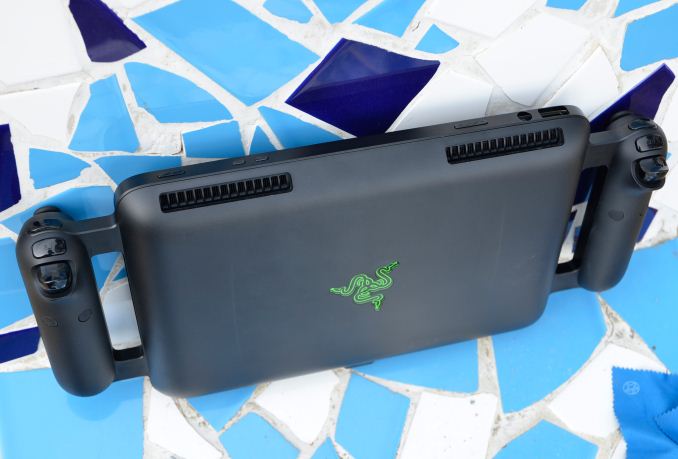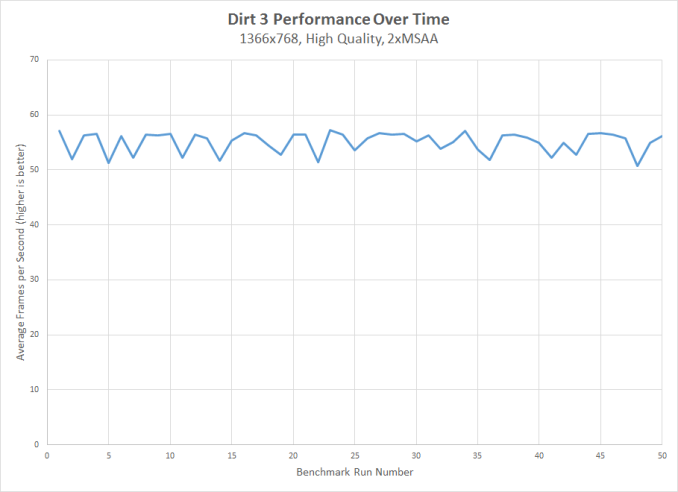The Razer Edge Review
by Vivek Gowri on March 28, 2013 11:00 AM EST- Posted in
- Tablets
- Mobile
- Razer
- Razer Edge
Thermals
The thermal story here is pretty interesting. Obviously, with a huge thermal envelope for such a small form factor, the first concern I had was for heat. Razer has a fair bit of experience shoving a lot of hardware in tight spaces, though with the Blade the problem construction was different. The Blade chassis is very thin, but has a lot of room in terms of footprint. The sheer amount of surface area top and bottom, as well as all the venting on the bottom and sides, help the Blade (especially the 2nd generation one) effectively cool itself even though there’s relatively little volume available.
The Edge, by comparison, has a tiny footprint and hence needs to be much thicker than competing tablets; it’s actually also thicker than the bottom casing of the Blade, so there’s that too. Airflow is extremely key here, since there’s very little surface area to let heat dissipate convectively. The heat pipe, too, is key, as tablets have far more orientations that need to be designed for when compared to notebooks. Orientation matters for heat pipes, as their effectiveness depends on how much working fluid can be transported from the condenser to the evaporator. Operating against gravity is always a losing proposition, and as such there’s an inverse correlation between transport capacity and operation against gravity (ie, as the angle of operation against gravity increases, the transport capacity of the heat pipes typically decrease.)
At some point in the future I’ll do a much more thorough article on how heat pipes and the cooling systems in mobile computers work, but for now this will have to suffice. The TL;DR version as pertinent to this article: if you have enough compute horsepower in a tablet to require active cooling, you’re in for a hell of a time. Tablets are much harder to cool actively than notebooks.
Which is why thermal performance was, for me at least, the major concern with the Edge prior to launch. The 0.8” thickness helped alleviate my fears somewhat, because that gets you a significant amount of volume to work with compared to something like the Surface Pro. Ivy Bridge ULV and Kepler are also pretty good as far as thermal performance goes, so I wasn’t concerned at all about how it would behave under light usage cases, particularly ones that didn’t have the GPU turning on. But when the system is stressed, what then?
To find out, I fired up my 100% system load test – Furmark 1080p and wPrime 1024M (4 threads) looping, which maxes CPU and GPU – and let it run for a sustained period of time. I saw GPU temps hit 85C with ease, while CPU got up to 95C. The GPU temperature stabilizes in the 87F region at 0.887V (the voltage at 500MHz). CPU temp stabilizes in the low 90s, which is interesting because we typically see CPU temperatures that are lower than the GPU temps. CPU power draw hovers around 14.7W when both cores are loaded. The Edge reaches thermal equilibrium before it starts throttling the GPU, which is a good sign.
I also ran my real-world gaming situation with the Dirt 3 benchmark, and like last time, ran it 50 times in a row, this time on high settings with 2xMSAA at 1366x768, my graphics setup of choice for playing the game when the Edge was plugged in. The results were pretty interesting – while average framerates stayed in the 52-56 fps range for a majority of the tests, the minimum framerate told a good bit of the story. There are three primary speeds and voltages the GPU runs at: the default 500MHz (0.887V), 570MHz (0.912V), and 405MHz (0.813V). In many of the runs in the 55-57fps range, the minimum framerate would be around 45-46fps, while some of the runs that had average fps on the low end (51-52fps), the minimum framerate would be below 40, sometimes as low as 35 fps. This happened every three or four runs, with consistency, with the GPU clocking down to the lower voltage performance state when necessary in order to maintain thermal equilibrium. At no point was there an extended period of throttling, which is why performance remained mostly constant for the roughly two and a half hours it took to go through 50 runs of the benchmark. That’s pretty impressive, considering the amount of thermal stress the GPU puts on a system of this size.












89 Comments
View All Comments
HisDivineOrder - Thursday, March 28, 2013 - link
If you were told that the spec is TN panels and you were given an IPS, then that means you were given a cherry picked unit and many of the launch units will include a TN panel and still be "up to spec."Whoops.
Also, I think it's pretty short sighted to say, "Well, 1366x768 is fine because gaming is going to be bad on a 1080p panel with that GPU." First, not every game is Crysis 3. Second, not everyone is going to want a decent PC-based tablet just to game. Some of them are in fact going to watch movies and/or web browse from time to time and having a high resolution panel would benefit them.
Perhaps Razer should have spec'ed a 2560x1440 panel to give the best of both worlds. Excellent with all content except games and a great way to down-rez to 1280x720 for high end gaming.
Considering the high cost of this thing (including one of those peripherals in your purchase price is a necessity), I think a high res panel is the least they could have done.
Anyway, good review except for you're constant apologies for Razer's mistakes. Also, I can't help feeling like this device REALLY reminds me of the first Razer Blade. The one that came out just before Ivy Bridge and sucked, only to be replaced in a few months time by a version that included IB, better power per watt, better everything, and a slightly lower price.
With Haswell incoming, buying one of these based on IB is downright wasteful since anyone who would want this will want that, too. Might as well wait.
Especially when the keyboard add-on isn't even ready for primetime.
VivekGowri - Friday, March 29, 2013 - link
Pre-launch, I was told TN, but that was apparently a mistake - all specsheets and units (preproduction as well as final production) I have encountered have been IPS. The production version has always been IPS, there's been nothing to indicate that mine was a cherry picked unit.royalcrown - Thursday, March 28, 2013 - link
Everyone is free to like what they will, here is my 2 cents on this thing:1. Ugly as hell
2. Pretty fat and bulky
3. Waay overpriced
Really, for what this thing costs base price, you can go buy a laptop that has all the same features or more, is just about the same thickness, already has all the "optional" ports, charger and other crap, more storage. That's before the overprived accessories.
For all the people that think, "But I can haz buttunz own itz." just add a ps3 controller to a laptop or use motionjoys PS3 controller driver and you have the same or better.
coolhardware - Thursday, March 28, 2013 - link
I'm not quite sure why so many people are hating on the Razer Edge and Vivek's review.He liked the machine and had a lot of fun playing games on it, he addresses the weaknesses and the strengths. He came to a conclusion and it is not an absurd one.
The tech industry needs visionaries and companies that release bleeding edge products. Not every original release can be as polished as we would like, I would argue that the opposite is true... most initial genre creating products have some pretty rough edges!
Kudos to Razer for having the balls to produce something like this: a tablet that can play PC games (without having to stream them from somewhere else).
Kudos to Vivek for taking the time to review and benchmark it so we can read about if for free and come to our own conclusion about purchasing it or not.
Now, what I would like to know a bit more about:
+can it easily be taken apart? (b/c I would like to know about upgrading the SSD)
+what is the warranty?
+what interface does the dock use (like what bandwidth does it have and what does the connector look like) [they mention that they didn't put USB3 on the dock there b/c not enough bandwidth, and that surprised me...]
Anyhoo, thanks for the review Vivek, I appreciate it!!!
bountygiver - Thursday, March 28, 2013 - link
it's a tablet, upgrading yourself is obviously not going to be easy, the question is only how hard?coolhardware - Friday, March 29, 2013 - link
Exactly.re we talking Surface Pro hard (i.e. sure it uses mSATA but you'll likely break it to upgrade it), or Dell XPS 10 (relatively easy). More info about tablet serviceability here: http://www.jdhodges.com/2013/03/tablet-teardowns/
althaz - Thursday, March 28, 2013 - link
I like this (A LOT), but the price point is too high. The $1499 bundle probably needs to be under $1000. The weight and thickness honestly don't bother me overly.Wolfpup - Thursday, March 28, 2013 - link
Cool that they actually pretty much pulled this off. I'd loooooove to have one, but realistically the money is better spent towards a normal, more powerful notebook (just got an M17x-R4 with a GTX 680).I wish that you got the features of the HDMI dock (either through the dock or built in) plus the second battery, plus the controller dock all included at any of the price points...I'd feel better about that price-wise. Interesting how it might handle games that really need a mouse and keyboard too...and yeah, it ought to have first party controller-as-mouse support, considering.
Darbyothrill - Thursday, March 28, 2013 - link
You would think that they would have wanted to wait for Haswell, considering Intel's claims that the GPU competes with the 650m.Jumangi - Thursday, March 28, 2013 - link
The Vita can't sell at $250 but a heavy $1000+ tablet based around gaming will? How does this stuff get past being laughed at during the boardroom meeting and get actually made?